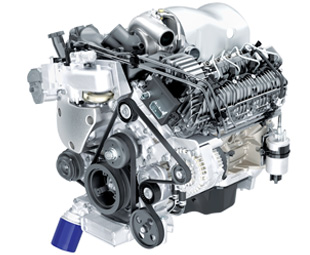Much ado about diesel

Diesel engines have become very popular, mainly because of their favourable fuel consumption, but also because in turbo diesel forms, the torque output is so high that they’re fun to drive.
Looking at the pros and cons of diesel engines, we start with the main pro: fuel consumption. Why does a diesel engine use less fuel than a petrol engine of the same capacity?
THE MAJOR REASONS ARE:
It runs on a lean mixture
Only air is inhaled and fuel is squirted in just before top dead centre, in quantities proportional to the power demanded by the driver. Each fuel droplet burns at more or less the same mixture strength as in a petrol engine, but at low power demands. The excess air in the space above the piston means that the overall mixture strength is much leaner than in a petrol engine. A petrol engine will not run unless the overall mixture strength is chemically correct because it inhales a mixture of fuel and air. Even at maximum power output, a diesel engine still has about 20% excess air in the combustion space and the combustion process is such that any attempt to add more fuel simply results in smoke being formed.
It has very low pumping losses
The losses incurred by a restriction in the intake manifold are called pumping losses. Modern diesels do not have a throttle butterfly, because the amount of power delivered is controlled by the amount of fuel injected. This means that intake manifold pressure is close to atmospheric instead of being a partial vacuum, as is the case with a petrol engine. At low power demands, a greater volume of air will rush into the engine when the inlet valve opens than in the case of a petrol engine, so that breathing efficiency is improved.
It has a high compression ratio
A diesel engine needs a high compression ratio so that the resultant high air temperature can supply the heat to ignite the fuel. This temperature also ensures that the combustion is efficient, but this process has a limit. As the compression ratio goes up, so does the thermal and mechanical stress in the engine, so that the value chosen (between 16:1 and 20:1) is always a compromise. Another benefit of the high compression ratio is the high expansion ratio. During the exhaust stroke, this results in capturing energy from the exhaust process that would normally go to waste. The practical effect is a significantly colder exhaust gas temperature in a diesel than you would measure in a petrol engine. Less heat also flows to the cooling water so that a diesel cooling system often has a slightly lower capacity.
What are the disadvantages of diesel engines?
1. Because a diesel always runs lean, it usually develops about 20% less maximum torque per litre than an equivalent petrol engine.
2. This explains why the power per litre is also significantly less than you will find with a petrol engine. The potential for more power is further restricted by the delay period between the time fuel is injected and the time taken to evaporate enough to start burning. This results in the combustion process being slow enough to limit the maximum revs to 3 500 or, at most, 4 500 r/min, on a small diesel engine, and even lower on a bigger diesel.
3. Both these limits can be overcome by adding a super- or more likely a turbo-charger to a diesel. This usually works extremely well because the lack of a throttle butterfly results in the airflow in the intake manifold pulsating less than in the case of a petrol engine. The addition of a turbo, which runs at anything from 80 000 to over 200 000 r/min, depending on size, introduces a complication that can make diesel engines less reliable and durable than petrol engines.
4. Servicing a diesel is very important and required more frequently than a petrol engine. Dirty fuel, air and oil filters can quickly cause damage to a diesel engine. For example, a partly blocked air filter will reduce the excess air inside the engine and cause overheating whereas the same fault in a petrol engine will enrich the mixture, and not cause overheating.
5. Diesels are more expensive because of the intricate fuel injection equipment, as well as the high compression ratio, which introduces stresses that require a very robust construction.
6. Diesel exhaust gases contain soot particles that are more costly and difficult to dispose of than in the case of petrol engines.
Published by
Focus on Transport
focusmagsa



